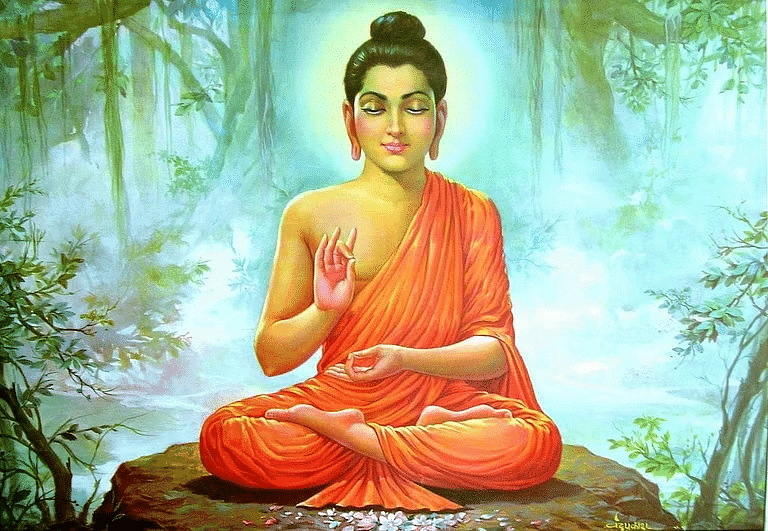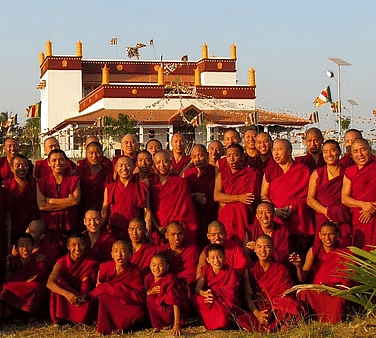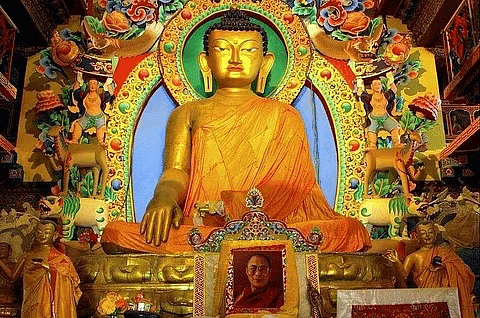Class 6 History Chapter 6 Notes - New Questions and Ideas
| Table of contents |

|
| Life Story of Gautama Buddha |

|
| Upanishads |

|
| Jainism |

|
| The Sangha |

|
| Viharas |

|
| Some Important Questions |

|
Imagine a long time ago, in a peaceful land called India, there lived a special person who would go on to change the world. His name was Buddha, and he was not a king or a warrior, but a wise and compassionate teacher. Buddha's story is one of self-discovery, kindness, and the pursuit of happiness.
Today, we'll learn about the life and teachings of this remarkable figure who continues to inspire millions of people around the globe.
Life Story of Gautama Buddha
- The creator of Buddhism is Siddhartha. He was also known as Gautama.

- Gautama Buddha was born around 2500 years prior.
- Buddha was from a little 'Gana' named Sakya Gana. He was a Kshatriya by birth.
- He went out from home at an early age to discover more information about the existence and its sufferings and to check those.
- Wandering for many years, he met and discussed with other thinkers everywhere.
- After an extended period, he finally decided to find his own way to enlightenment. He meditated for several days under a Bodhi tree in Bodh Gaya, Bihar. This stage in the life of Buddha Shakyamuni is called enlightenment. Afterward, he became enlightened and was named the Buddha or " Wise Man."
- The Buddha's next destination was Sarnath, near Varanasi. He taught their for the first time.
- The rest of Buddha's life was spent walking from one place to another. The only thing he did during this period was teach people.
- His last teaching was in Kusinara.
Buddha’s Teaching
- In Buddha's teachings, a person's life is full of suffering and unhappiness. The main reasons behind misery and unhappiness are cravings and desires which cannot be fulfilled.

- According to the Buddha, even if these wishes are fulfilled, people will not be satisfied and want more.
- The Buddha described this particular concept as "thirst or tanha".
- He taught people to reduce or lessen their desires by following moderation in everything.
- Generosity and respect for others (including animals) were one of the central teachings of the Buddha.
- According to the Buddha's teachings, the results of our actions, whether good or bad, affect us both in this life and the next. These actions are known as karma.
- The Buddha taught in the language of ordinary people, Prakrit, so that everybody could understand.
- Lastly, he also encouraged people to think for themselves.
Upanishads
- Before the time of the Buddha, people were struggling to find answers to complex problems.

- People are curious about life after death and the reason behind the sacrifice.
- Most thinkers believe that there must be something permanent in the universe that would last even after death.
- This particular phenomenon is called atman or individual soul and Brahman or universe soul. They believed that Atman and Brahman are similar.
- The thoughts of those thinkers are recorded in the Upanishads. These were part of the later Vedic texts that followed.
- Upanishad means "approaching and sitting near". The dialogues between teachers and students are included in the text. Sometimes a very simple dialogue represented ideas.
- Generally, the thinkers of the Upanishads were men. More specifically, most of them are Brahman and Raja.
- Occasionally, there is mention of women thinkers, such as Gargi, Apala, Ghosha, and Maitreyi, who were famous for their learning and participated in debates.
- Most of the debates and discussions did not allow the poor to enter.
- There was one exception. One of the best thinkers at the time was Satyakama Jabala, a slave. He wanted to learn about reality and was taught by a Brahmin teacher named Gautama.
- The famous thinker Shankaracharya put forward several essential ideas in the last part of the Upanishads.
Panini, the Grammarian
During Buddha's time, there was a famous scholar named Panini. He created a grammar for Sanskrit, a language from that era. Panini arranged the sounds of Sanskrit in a special order and used formulas, like in Algebra, to write down the language rules. He came up with around 3000 short formulas, which made it easier for people to learn Sanskrit. His work is still important for scholars today.
Jainism
- In the same period as Buddha Shakyamuni i.e 2500 years ago, the last of Jainism and the 24th generation Tirthankara, Vardhamana Mahavira, also spread his message.

- He belonged to the Lichchhavi dynasty and was born in Kshatriya. Lichchhavis is part of Vajji Sangha.
- At the age of 30, Mahavira left home and began living in the forest.
- After twelve years of hardship and loneliness, he has attained enlightenment.
- He taught a simple doctrine that men and women should leave home to let know the truth about their lives.
- Mahavira taught that they must follow the rules of "ahimsa", which means not hurting or killing living beings.
- "All beings" "long to live. To all things, life is dear".
- Mahavira preached in Prakrit so that ordinary people could understand his philosophy.
- Prakrit was given different names in different parts of the country. For example, Prakrit in "Magadha" was known as Magadhi.
- The followers of Mahavira were called Jainas.
- They led a simple life and used to collect food by begging.
- Jains were very honest and did not steal.
- They had to obey celibacy, men had to give up everything. Even their clothes.
- The Jainism Rules were difficult to follow. However, people left the house to get a new way of living for lessons.
- Jainism was followed by traders. However, it was difficult for farmers who had to kill insects to save their crops.
- Mahavira and its teachings spread to different parts of India including Gujarat, Tamil Nadu, and Karnataka.
- These were transmitted orally for several centuries.
- Later, they were written down and are available in Valabhi in Gujarat.
Jaina: The word "Jaina" is derived from the term "Jina," which means conqueror.
The Sangha
Both Mahavira and Buddha felt that men and women who left their homes could gain knowledge.
They lived in a place together known as Sangha.
 Sangha
Sangha
Buddhist sangha rules were written in a book, known as Vinaya Pitaka. And from this, we get to know that there were separate branches for men and women.
All men could join but the children had to take permission from their parents, slaves from their masters, workers from their king, debtors from their creditors, and women from their husbands.
Men and women meditated for most of their time and went to cities and villages to beg for food. For this, they were known as bhikkhus and bhikkhunis.
Several sects participated in Sanghas, including Brahmins, Kshatriya, merchants, laborers, barbers, courtesans, and slaves.
Viharas
 Tawang Viharas
Tawang Viharas
- Both Jaina and Buddhist monks traveled throughout the year, teaching people.
- During the rainy season, when travel was difficult, they stayed in one place.
- Supporters built temporary shelters for them in gardens or they lived in natural caves in hilly areas.
- The need for more permanent shelters arose for the monks and nuns (bhikkhus and bhikkhunis).
- Monasteries known as viharas were built to serve as permanent shelters.
- Early viharas were made of wood, later transitioning to brick structures.
- Some viharas were even built within caves, particularly in western India.
- Rich merchants, landowners, or kings often donated land for the construction of viharas.
- Local people provided food, clothing, and medicines as gifts for the monks and nuns.
- In return, the monks and nuns taught the people and spread Buddhism.
- Buddhism spread across the Indian subcontinent and beyond over the centuries.
- A new form of Buddhism called Mahayana Buddhism emerged.
- Sculptures of the Buddha became prevalent, depicting his enlightenment and other aspects.
- Mahayana Buddhism introduced the concept of Bodhisattvas, enlightened beings who remained in the world to help others.
- Worship of Bodhisattvas gained popularity, spreading to Central Asia, China, Korea, and Japan.
- Buddhism spread to western and southern India, where caves were carved out of hills for monks to live in.
- Buddhism also expanded southeastwards to Sri Lanka, Myanmar, Thailand, and other parts of Southeast Asia, including Indonesia.
- Theravada Buddhism, an older form of Buddhism, was more popular in these regions.
Stages of life: Ashramas
In life, there were different stages called "ashramas" that people followed. Ashram simply means a stage of life. There were four recognized ashramas: brahmacharya, grihastha, vanaprastha, and samnyasa.
- During the first stage, called brahmacharya, individuals, such as brahmanas, kshatriyas, and vaishyas, were expected to lead simple lives and focus on studying the Vedas.
- After that, they entered the grihastha stage, where they got married and lived as householders, taking care of their families and fulfilling their responsibilities.
- As they grew older, they entered the vanaprastha stage. During this stage, they would retreat to the forest, away from the hustle and bustle of everyday life, to reflect and meditate.
- Lastly, there was the samnyasa stage. At this point, individuals would renounce everything and become samnyasins, dedicating themselves fully to a spiritual path.
Some Important Questions
Q.1. Describe the ways in which the Buddha tried to spread his message to the people.
The Buddha tried to spread his message to the people in the following ways:
1. He conveyed his teaching in the Prakrit language, which was the language of the common masses.
2. He encouraged his followers to think over his messages instead of blindly following them. This helped his ideals spread further. The encouragement of free thinking meant that people could come to conclusions based on his ideas on their own.
Q.2. What were the main teachings of Mahavira?
The following are the main teachings of Mahavira:
1. Those who wish to know the truth must leave their home.
2. Those who are on the path of truth must adhere to the principles of Ahimsa (Non-violence) very strictly.
3. One must not hurt or kill any other living being, as life is dear to all.
FAQs on Class 6 History Chapter 6 Notes - New Questions and Ideas
| 1. Who was Gautama Buddha and what was his significance in Buddhism? |  |
| 2. What are the main teachings of the Upanishads? |  |
| 3. How does Jainism differ from Buddhism? |  |
| 4. What is The Sangha and what role does it play in Buddhism? |  |
| 5. What are Viharas and their importance in Buddhist practice? |  |
















